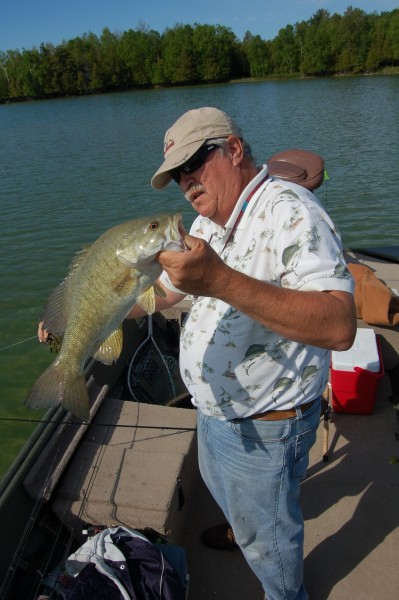Fishing Petoskey: A Lesser-known Michigan Angler’s Paradise
Bob Gwizdz 08.13.15

Jon Howard is a Hoosier, born and raised, but he’s invested a good portion of his life fishing in Northern Michigan. He’s spent time in Traverse City, Cheboygan, Elk Rapids, and the Leelanau Peninsula. Then, about 30 years ago, he started fishing in Petoskey. He’s gone back ever since.
When he wanted to buy a retirement home, he got a place overlooking Little Traverse Bay, because it offers outstanding smallmouth bass fishing but is a little off most bass anglers’ radar.
Howard said he can catch a big number of smallmouths at any given time, but what really makes Little Traverse Bay stand out is the number of big smallmouths he catches.
“Last spring I had 12 that weighed more than six pounds and one over seven by the end of June,” said Howard.
Howard spends most of his time on the bay fishing around drop-offs, where the bottom falls from shallow to deep in an instant—it’s easily told by the change in water color—but also looks for submerged weeds or giant rocks.
“Submerged logs are good,” said Howard, who guides anglers form a 17-foot johnboat. “If you find anything different, there’s a good chance there’ll be two or three fish on it. Big rocks can be good, but they’re not that different; there are a lot of them. There are some good patches of narrow-leaf cabbage, but it hasn’t come up that well this year. Ice-off was late and spring was colder than usual.”
But it’s not just bass that the bay offers.
“I catch a lot of browns [trout], lake trout and steelhead,” he said. “This spring we had a lot of lakers and steelhead. But we also catch whitefish and lake herring, too. Spring and fall are when you catch a lot of the odd species.”
But Howard is quick to tell you he can’t count on fishing Lake Michigan every day (especially in a shallow-drafting boat)—and that’s what makes Petoskey shine: the surrounding inland lakes are outstanding.

Petoskey is a just a long cast from Crooked Lake, where the inland waterway commences. Crooked Lake offers outstanding smallmouths, and feeds into Pickerel Lake, which offers quality bass fishing for both largemouths and smallmouths. But Crooked also feeds into Burt Lake, which feeds into Mullet; Burt and Mullet are among the best smallmouth fisheries in the state. Both offer good perch fishing, too, as well as a deep-water rainbow trout fishery.
“I catch a lot of walleye in Crooked Lake,” Howard said. “Lake Charlevoix is good—the walleyes have really come on in the last few years. Walloon Lake is good for both bass and walleye. Pickerel has walleyes and, of course, Burt and Mullet.”
About 25 miles northeast of Petoskey is 3,300-acre Douglas Lake. A good lake for both largemouths and smallmouths, Douglas Lake is probably better known for pike. There’s very little development—the University of Michigan owns almost the entire southern shore—so Howard often goes there on days he expects a lot of boat traffic elsewhere. Douglas Lake is the headwaters of the Maple River, which is a blue-ribbon trout stream.
A little northwest of Douglas, Larks Lake is a shallow, marl-bottom, 1,000-acre lake that offers excellent smallmouth fishing. I fished it with Howard a number of years ago; we caught more than 40 and had some four-pounders.

Howard also likes 1,900-acre Lake Paradise (historically known as Carp Lake), a little north of Douglas, for largemouths, smallmouths, walleye, and pike. And the Upper Peninsula is close enough that he’s not afraid to head up there for a day. Just south and west of the bridge, Wilderness State Park offers excellent smallmouth fishing off Waugoshance Point.
But it’s Little Traverse Bay that makes Howard’s eyes light up. He caught his best-ever smallmouth—eight pounds, two ounces—on Little Traverse Bay.
“The key on any given day is whether or not the smallmouths move up from deep water,” said Howard, who is adamant about catch-and-release bass fishing. “You can fish along a ridge and catch nothing, then come back the next day and catch a boatload. I’ve got places where I can catch them deep—down to 60 feet—but I don’t like to do it. It’s too hard on the fish.”
The Bear River, which runs through downtown Petoskey, is known for its salmon, steelhead, and brown trout runs. Even small creeks (Tannery Creek, for instance) get a steelhead run.
A little to the south, near Lake Charlevoix, Medusa Creek, a small, man-made creek that was created by pumping water from the limestone quarries at a cement plant, attracts salmon anglers in the fall. And the Jordan River, the largest tributary to Lake Charlevoix, offers world-class brook trout fishing and is popular with the fly fishing set.
All said and done, it’s pretty easy to see why Howard chose Petoskey for his retirement fishing headquarters.
For more information on Michigan fishing go to michigan.org. Click here to purchase a Michigan fishing license online.
This article was produced in partnership with Pure Michigan.

